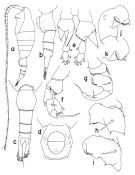|
|
 |
|
Calanoida ( Order ) |
|
|
|
Arietelloidea ( Superfamily ) |
|
|
|
Heterorhabdidae ( Family ) |
|
|
|
Heterostylites ( Genus ) |
|
|
| |
Heterostylites submajor Park, 2000 (F,M) | |
| | | | | | | Ref.: | | | Park, 2000 (p.42, figs.F,M, Rem.) |  issued from : T. Park in Bull. Scripps Inst. Oceanogr. Univ. California, San Diego, 2000, 31. [p.173, Fig.21]. Female: a, habitus (left side); b, c, urosome (left, dorsal, respectively); d, genital somite (ventral). Male: e, P5 (distal exopodal segments omitted), anteror; f, left P5 (posterior); g, right P5 (endopod omitted), posterior; h, second exopodal segment of right P5 (posterior); i, idem (tilted clockwise; j, idem (anterior); k, idem (tilted clockwise). Nota: Prosome length 3.17-3.58 mm.
|
 Heterostylites submajor Heterostylites submajor female: 1 - Dorsally, genital somite widest at middle. 2 - Ventrally, genital operculum much wider than 1/2 width of somite. 3 - Laterally, ventral margin of genital somite extending straight beyond posterior end of genital operculum (Fig.21-b). 4 - Laterally, 2nd urosomal somite with straight ventral margin; setae of mouthparts not conspicuously plumose.
|
 Heterostylites submajor Heterostylites submajor male: 1 - Basal lobe of right P5 relatively short (Fig.21-e); basal lobe of left P5 low and wide. 2 - In 2nd exopodal segment of right P5, medial projection with a long serrated process (Fig.21-h). 3 - Setae of mouthparts not highly plumose.
| | | | | NZ: | 4 | | |
|
Distribution map of Heterostylites submajor by geographical zones
|
| | | | | | | | | | Loc: | | | off W South Africa, SW Indian, America (central W, off W Guatemala, China Seas (East China Sea).
Type locality: 05°39'N, 83°04'W. | | | | N: | 1 | | | | Lg.: | | | (824) F: 5,5-4,75; M: 5,08-4,56; {F: 4,75-5,50; M: 4,56-5,08} | | | | Rem.: | Most probably in the deep layers.
For Park (2000, p.43) this species closely resembls H. major (see remarks in the latter), but can be distinguished from it in the female by the genital somite, which has strongly bulging lateral margins, the genital operculum in ventral view, of which the posterior half is relatively narrow and papering posteriorly, and the 2nd urosomal somite, which has a straight ventral margin.
Characters by which the male of this species can be distinguished from that of H. major are quite subtle. However, if they occur together, they are easily distinguished from each other by the differences in body size, length of A1, and appearance of the long setae on A2, Md and Mx1. For example the two sepecies occurred together in a sample from off Guatemala (E Pacific), and their body lengths were 5.00-5.08 mm in H. submajor and 4.66 mm in H. major. The long setae of A2, Md and Mx1 in the latter were strikingly more plumose with densely packed long setules than in the former.
After Park (2000, p.143), the species occurred in all three major oceans but was confined mainly to coastal waters. | | | Last update : 17/10/2017 | |
|
|
 Any use of this site for a publication will be mentioned with the following reference : Any use of this site for a publication will be mentioned with the following reference :
Razouls C., Desreumaux N., Kouwenberg J. and de Bovée F., 2005-2025. - Biodiversity of Marine Planktonic Copepods (morphology, geographical distribution and biological data). Sorbonne University, CNRS. Available at http://copepodes.obs-banyuls.fr/en [Accessed October 20, 2025] © copyright 2005-2025 Sorbonne University, CNRS
|
|
 |
 |




